I begin this piece with the above advertisement from the Norfolk Chronicle – Saturday, 24 October 1885 (1). Note this advert is for a self-cocking, ejecting, hammer gun. This gun is the focus of the following article. Figure 2 A general description of the gun is as follows: Weight: Just shy of seven pounds Length of Pull: 14 inches Chamber: 2 ½ inches Barrel Length: 28 inches
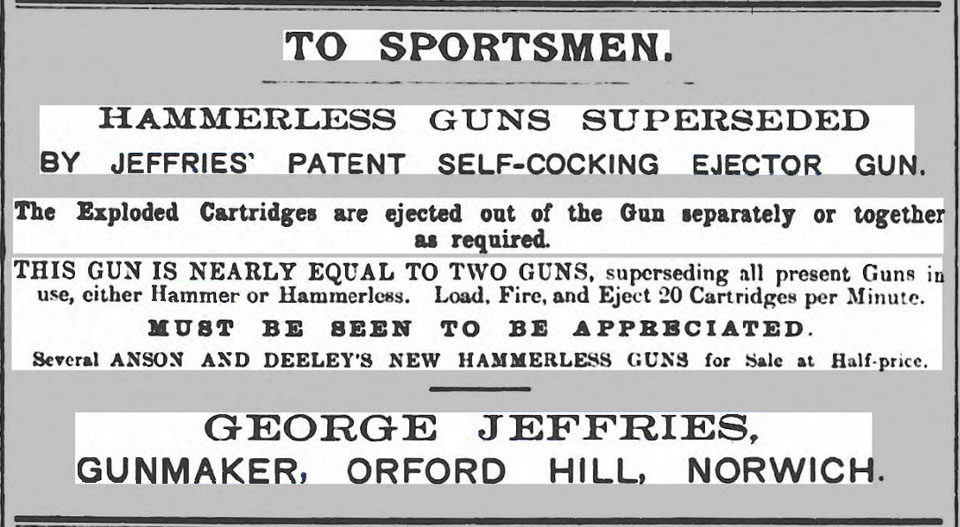
George Jeffries Little is known of the gunmaker, George Jeffries. “Jeffries established in 1841 at Stepping Lane, moving to larger premises at Golden Ball Street the following year. In 1864 moved they moved to 8 Oxford Hill. George Jefferies died on 31 May 1897, but business continued until 1899.” (2) His primary fame [little, though it may be], is for making of side-opening shotguns, under patent number’s 22 and 3200 of 1862 (3). In the early to mid-1860s, gunmakers were tackling the problem of finding a strong locking method to prevent the barrels from coming off-face.
Many of the actions were static, including the more popular Jones underlever and the Dougall slide-and-drop actions. The Jeffries side-opening gun was another of these solutions. In the Jefferies case, a wedge on the bottom of the barrel, slid into a matching, tapered slot in front of the standing-breech, much like a drawer’s dovetail. This was a strong action indeed and must have taken a great deal of skill to fit properly.
Jeffries also held a patent on a cartridge loading apparatus, number 1900 of 1860, “but late in life he attempted to make a machine which was capable of perpetual motion” (3). [The laws of physics apparently did not slow George down].
The Sad Tale of Jeffries Self-Cocking, Ejector Hammer Gun
Those readers who are purists, may find this a sad tale, for this gun has seen better days. It had hard use and was not properly cleaned and maintained. There had been a number of modifications prior to my obtaining it. The gun has Birmingham proofs, following the 1875 to 1887 proof laws. The left barrel was marked “13B/14M NOT FOR BALL,” indicating that it had had some choke. Both barrels were now cylinder. The gun had been re-proofed for black powder following the 1954 to 1989 proof laws with bore measurements of .729.
The major change was to the butt stock. Originally the butt stock been some type of pistol-grip. If it matched the original forend, it was well-figured. The replaced stock is a very plain, straight-grip stock. Since the original trigger-guard was now too short, the solution was brazing part of a straight-stock trigger-guard, with its long tang, from another gun, onto the front of the original trigger-guard. Now, since the engraving on the guard tang did not match, it was removed.
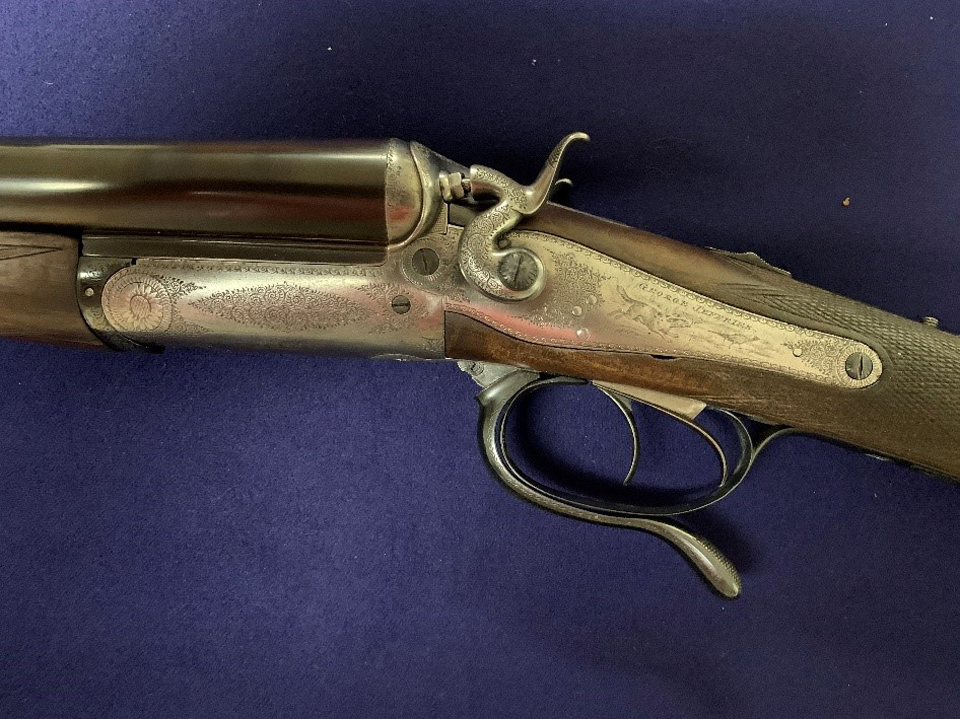
I am not a purest when it comes to English shotguns and I like my guns to be aesthetically pleasing. I will have to admit that I made further changes to the gun. Somewhere along the gun’s history, most of the screws had been replaced. I had them re-slotted and engraved to match the remaining originals. Internally the barrels, they were in perfect condition, except for the last 1 ½ inches, which were very badly rusted and very thin. Since both barrels were already cylinder and 30 inches long, I saw no reason not to cut them to 28”, resulting in a perfect set of barrels. This I did (horrors)!
I cleaned the action, had the trigger-guard tang engraved with the serial number inscribed. I also had the barrels re-blued. All of this work and expense may not have been fiscally justified, but I thought such an unusual gun deserved the effort.
The Closer One Looks, the More Unusual it Gets
A self-cocking, ejector hammer gun is unusual enough, but other features make this gun design unique. The design patents, which are reflected in my gun, were granted to Jeffries as numbers 7895 and 3400, dated 1885 and 1886, respectively. The gun’s action follows patent 7895 but the forend design is that of patent 3400. The gun was probably built around 1886.
Barrels
The barrels are fluid steel. While steel was in use at this date, Damascus was more common.
Action
The hammer action is non-rebounding, i.e., there is a half-cock safety. See Figure 3. Most locks followed the Stanton rebounding patent by the late 1880s. In addition, there is an automatic tang safety, also unusual on a hammer gun, since one can see if the hammers are cocked or not.
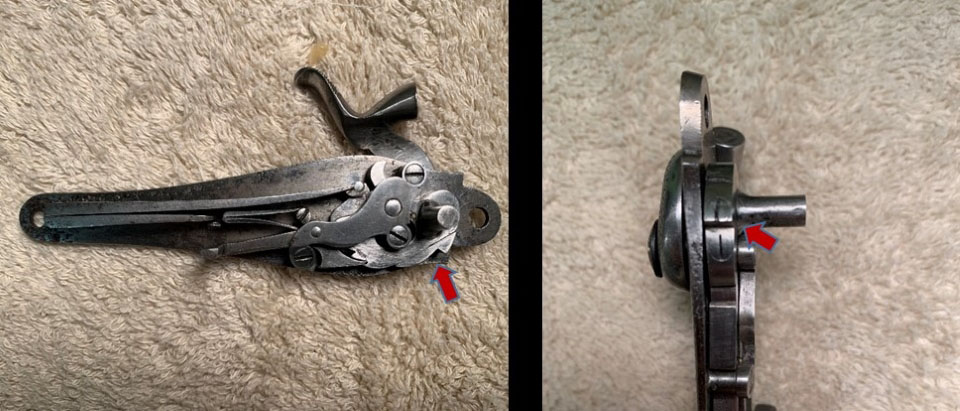
The hammer in Figure 3 is at the half-cock (safety position). The full-cock bent is hidden under the bridle. At close inspection the tumbler appears to have four bents, rather than the normal three associated with a non-rebounding lock. The forward “bent” is really not a bent (see arrows in Figure 3), but a notch which engages the ejector tripping rods.
The lock-work is less than elegant. It appears that Jeffries purchased a standard non-rebounding lock and then modified it, adding this notch, rather than filing up a new tumbler to meet his unique design. The right image in Figure 3 shows the use of two screws to attach the additional element to the tumbler. These screwheads are filed off to meet the contour of the tumbler which is required to activate the ejector tripping rods.
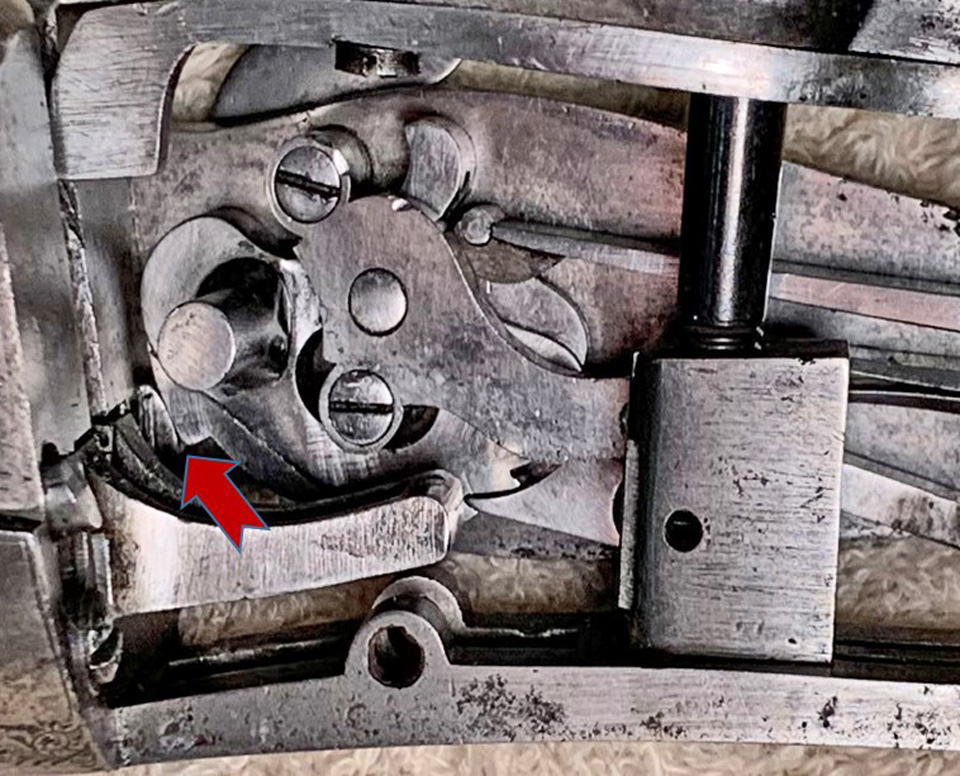
The arrow in Figure 4 points to the additional notch in the tumbler used to activate the ejector tripping rod. The hammer remains in the half-cock safety position. When the hammer is at full-cock position, the ejector tripping rod falls into the additional notch. On firing, the hammer falls, rotating the tumbler, which in-turn, forces the tripping rod forward, through the action bar, activating the ejector kicker. The end of the ejector tripping rod can be seen in Figure 4 resting on the tumbler, just in front of the additional forward notch.
The Ejector Cocking Mechanism
The ejectors are cocked using the “extractor rods [which] are separate flat slides fitted into slots … on the undersides of the breech-end of the barrels. A neat point is the use of a friction-reducing roller on the rear of each of these to ease their passage down the action face [standing breech] as the gun closed. [4].” The travel of the “friction-reducing roller (Figure 5, far right)” has significantly scored the standing breech of this gun.
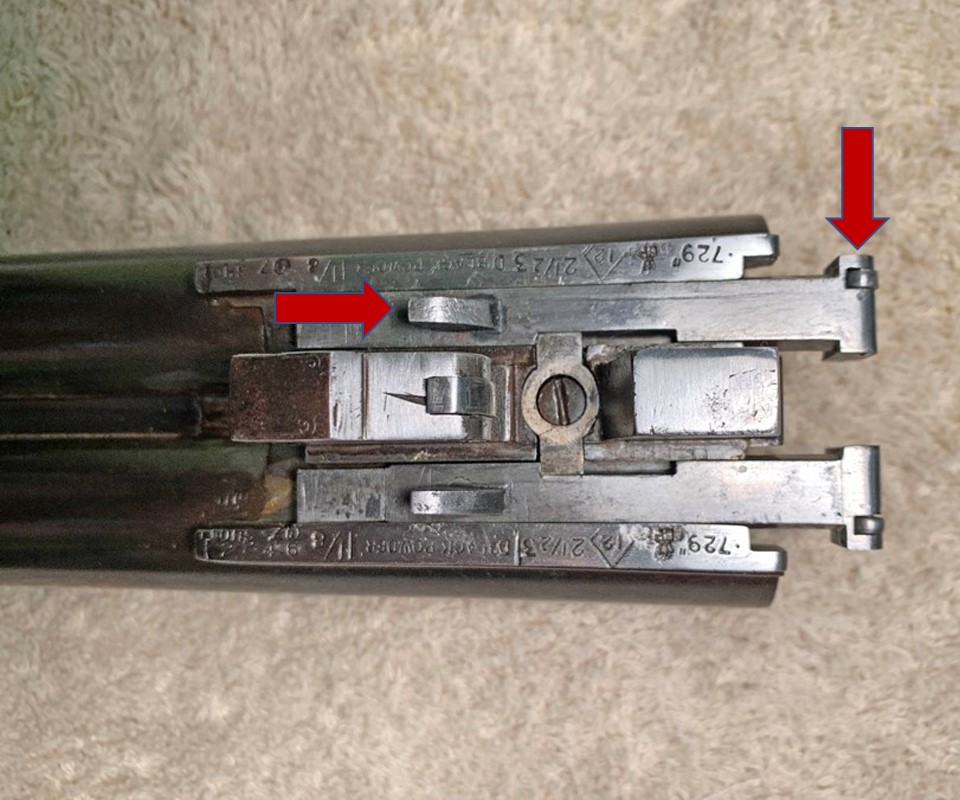
The Ejectors
The ejectors are simple but effective. The tabs on the extractor rods (Figure 5 arrow) are simply struck by the ejector kickers (Figure 6 arrow) when activated by the ejector tripping rods.
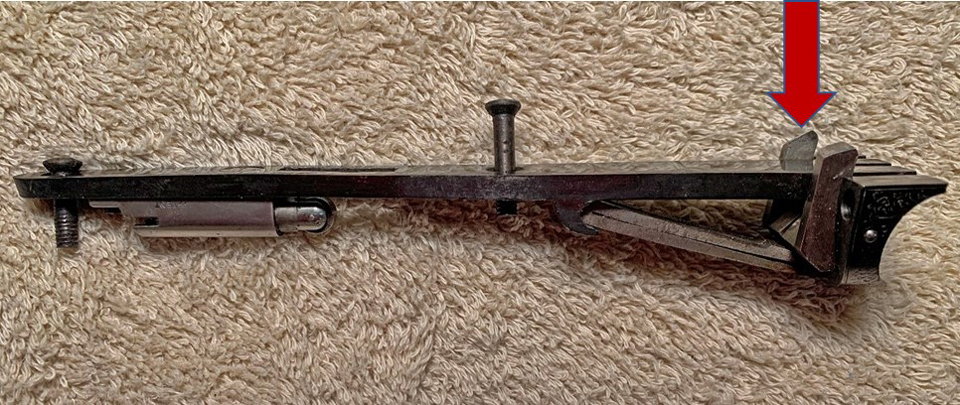
Operating the Gun
The Jeffries advertisement at the beginning of this article claims that 20 rounds a minute can be fired from this gun. Mr. Jefferies apparently had much stronger thumbs than I have. The gun is very awkward to use. The mainsprings are strong and operating the underlever is difficult. It is much more efficient to use by manually cocking the hammers. The automatic safety is a handy addition to a hammer gun.
Just Keep On, Keeping On
It is always exciting to find a high-grade vintage gun with its original case-hardening blazing with color, it’s Damascus barrels with original browning unworn, and a stock with the original, darkened finish showing through its marble-cake graining. On the other side of the coin is the mystique of a gun that has survived through many users, modifications, even abuse, and still keeps functioning. The Jeffries gun is certainly the latter. The fact that this very complex gun still works and will now return to the field to live on, is a credit to the skill and mastery of the English gun makers of the last century.
NOTES
1. British Newspaper Archives website: Norfolk Chronicle – Saturday, 24 October 1885. Home | Search the archive | British Newspaper Archive
2. Boothroyds’ Revised Directory of British Gunmakers by Geoffrey Boothroyd: Sand Lake Press, 1997. Page 212
3. The British Shotgun, Volume One, 1850 – 1870, by J. M. Crudgington & D. J. Baker: Quiller Press, 1989. Page 93
4. The British Shotgun, Volume Two, 1871 – 1890, by J. M. Crudgington & D. J. Baker: Quiller Press, 1989. Page 188
Published by Vintage Guns Ltd on




